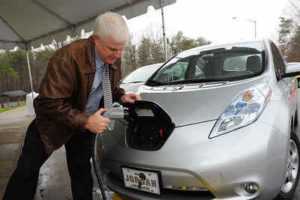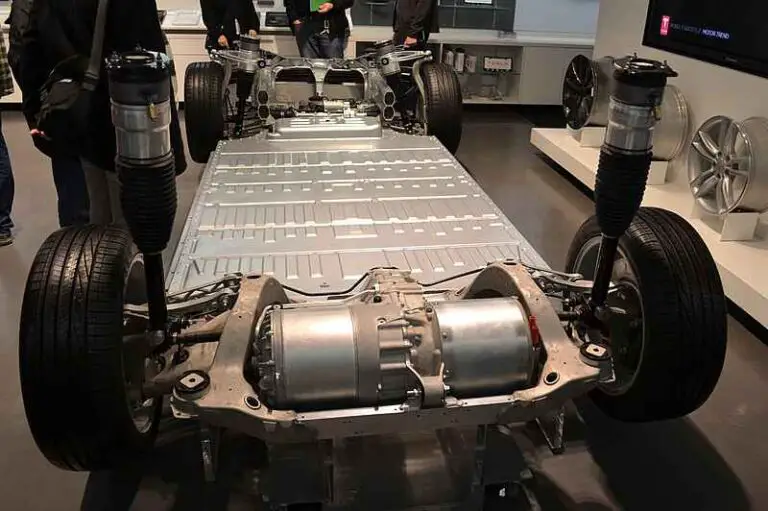7 Disadvantages of Electric Cars Explained
Disadvantages of electric cars are; ling recharge period, high cost, charging station issues, environmental degradation, range issues, battery capacity and safety, and unsustainable power sources.
This article discusses the disadvantages of electric cars, as follows;
1). Long Recharge Period (as one of the Disadvantages of Electric Cars)
Electric cars take more time to recharge compared to gasoline vehicles.
The amount of time required to recharge an electric car battery for a given amount of power and mileage is many times more than the amount required to refill a gasoline tank for equal mileage.
For example, gasoline cars typically take only a few minutes to refill, whereas electric vehicles can take several minutes to hours for a recharge.
The relatively-slow recharge rate is a problem for electric vehicles because it reduces their reliability and time-efficiency. It is also a major deterrent to potential users of electric vehicles.
It is important to note that the charging period depends on various factors such as the source of electricity, type of charger, state of charger and vehicle, and capacity of battery.
Efforts to address this problem so far include the development of fast-charging systems [2] and high-efficiency batteries.
2). High Cost
The cost of electric cars is high relative to gasoline cars.
These vehicles have an average cost of more than $50,000 (as of 2022), and majority of them range between $30,000 and $120,000.
Like recharge time, cost is another factor which has limited the adoption of electric cars. Similarly, investment costs for manufacturing electric cars is high compared to that for gasoline cars. This deters many potential manufacturers.
High cost of electric vehicles can be attributed to costly components and accessories. The battery is an especially expensive component that adds to the cost of these cars.
Also, the fact that electric cars are still in their developmental stage means that they are yet to be fully optimized for economic accessibility.
However, electric vehicles save cost on other factors like fuel and maintenance. The amount saved by EVs over their entire lifetime is estimated to range from $3,200 to $12,000 [4].
3). Charging Station Issues (as one of the Disadvantages of Electric Cars)
Electric car owners often face challenges with regards to charging station usage.
In countries where electric cars have not been fully introduced or adopted, the access to public charging stations is usually a problem. Although owners can install chargers at home, this can be challenging in cases of emergency.
Also, in regions without a reliable system of electricity generation and distribution, including faulty power plants and poorly-integrated smart grids, electric car charging stations may lack power supply when needed.
Chargers may also be faulty or slow, while charging stations may experience electrical and technical malfunctions.
Such problems as these make it less-compelling to depend on stored electricity as the sole source of power for cars. As a result, some users prefer hybrid cars which can also use fuel cell technology, liquid hydrogen, biofuel or gasoline.

4). Environmental Degradation
Although electric vehicles are known to use no fossil fuels, and to emit no greenhouse gases during their operation, the manufacture, charging and disposal or recycling of these cars may erase the effects of healthy environmental practices like soil conservation, water conservation, and general environmental remediation.
This s because there are stages and processes in the lifecycle of an electric car that cause the release of greenhouse gases and toxins into the environment.
The manufacture of electric cars, for example, involves raw material extraction through mining and drilling, and also requires electricity generation.
These requirements contradict the anti-climate change, anti-global warming, anti-poor air quality, and anti-environmental degradation image of electric cars, since they involve various forms of resource depletion and toxin production.
The sources used to generate electricity for mining, processing, welding, and other manufacturing activities, are not always clean, especially as a result of the relative immaturity and limited capacity of renewable energy at present. These sources are often fossil fuels like coal and petroleum which are heavy emitters of greenhouse gases, toxins and soot.
In efforts to align with the agenda of sustainable development and circular economy, electric car parts may be recycled after use [1]. This often involves thermal, mechanical or chemical treatment, all of which require energy.
What the above observations imply is that electric cars are not an optimal technology for achieving complete energy conservation, environmental sustainability and energy efficiency.
This does not detract from the many environmental advantages of electric cars. However, it indicates the need for further optimization of the technology to meet environmental requirements.
The battery of electric cars is a major cause of environmental degradation [6]. This is partly due to their composition that includes potentially-toxic elements like cobalt, nickel and lithium.
Extraction of raw materials, manufacturing of batteries, and disposal or recycling efforts, all involve risks of soil, air and water pollution. Such sustainability issues are being tackled as battery technology is modified.
5). Range Issues (as one of the Disadvantages of Electric Cars)
Range-related problems constitute one of the most common disadvantages of electric cars.
These problems arise from the dependence of EVs on stored energy in a battery. Since the range (distance covered) depends on available power, any abrupt power outage implies complete shutdown of the vehicle.
Unlike gasoline cars, refill for electric cars is only possible through electric charging. Charging stations are not currently as widespread as filling stations, and electric charge is not a portable commodity like most fuels.
Power outages can be caused by normal battery rundown, or energy losses due to overheating or battery faults.
Public sentiments regarding electric car range challenges are referred to as ‘range anxiety’ [5], and have been another factor limiting the adoption and advancement of electric cars.
Measures that can be taken to solve the range problem include establishment of more charging stations, improvement of energy security and resilience, and optimization of battery and thermoelectric technologies in electric cars.
6). Battery Capacity and Safety
The battery of electric cars has long been a topic of importance with respect to the safety of these vehicles [7].
Lithium ion batteries are currently the first choice for electric car energy storage, due to their advanced storage capabilities. However, the composition of these batteries make them susceptible to overheating and ignition.
Lithium batteries are temperature-sensitive and flammable. Energy losses, damage, and fire incidents are all risks involved in the use of electric vehicles, due to the presence of these batteries.
Forceful mechanical impact can also damage lithium batteries and may cause ignition.
The disposal of EV batteries poses a safety risk to the environment as well, as these batteries contain heavy metals and other components that are potentially harmful to the ecosystem.
Other types of batteries such as lead acid, are generally unsuitable, may also be unsafe, and have limitations of capacity.
Capacity problems in electric vehicles are a major issue because of the correlation between battery weight, size, and capacity [3]. High capacity batteries cannot always be used due to their weight and size, which may pose challenges to driving, and design efficiency.
Solutions to these challenges can be found only through innovation, research and development, to improve battery efficiency, energy density and safety.
7). Power Sources may not be Sustainable (as one of the Disadvantages of Electric Cars)
The power sources for charging stations are not usually renewable facilities like wind turbines; wind farms, solar panels, geothermal plants, biofuel-fired stations, hydroelectric systems or wave power plants.
Because renewable energy efficiency is still being optimized, it is more common for non-renewable sources like nuclear and fossil fuels to be used for electricity generation.
If the grid receives power from fossil fuel-fired power plants and generators, it implies that the use of such power is not a clean, sustainable, zero-emission, or environment-friendly process. This includes using the power to charge electric vehicles.
For electric vehicles to be truly clean and sustainable, the power sources must themselves be clean. As a result, a disadvantage such as this will persist for as long as renewable energy technology is incapable of serving as a reliable alternative to fossil fuels for electricity generation.

Conclusion
Disadvantages of electric cars are;
1. Long Recharge Period
2. High Cost
3. Charging Station Issues
4. Environmental Degradation
5. Range Issues
6. Battery Capacity and Safety
7. Power Sources may not be Sustainable
References
1). Baars, J.; Domenech, T.; Bleischwitz, R.; Melin, H. E.; Heidrich, O. (2021). “Circular economy strategies for electric vehicle batteries reduce reliance on raw materials.” Nature Sustainability 4(1). Available at: https://doi.org/10.1038/s41893-020-00607-0. (Accessed 11 September 2022).
2). Borges, J.; Ioakimidis, C.; Ferrão, P. (2010). “Fast charging stations for electric vehicles infrastructure.” ISLANDS 2010, Volume: 130. Available at: https://doi.org/10.2495/ISLANDS100241. (Accessed 11 September 2022).
3). Casals, L. C.; Macarulla, M.; Núñez, A. G. (2021). “High-Capacity Cells and Batteries for Electric Vehicles.” Energies 14(22):7799. Available at: https://doi.org/10.3390/en14227799. (Accessed 11 September 2022).
4). Lutsey, N. P.; Nicholas, M. (2019). “Electric vehicle costs and consumer benefits in Colorado in the 2020–2030 time frame.” Available at: https://doi.org/10.13140/RG.2.2.30375.29601. (Accessed 11 September 2022).
5). Pevec, D.; Babic, J.; Carvalho, A.; Ghiassi-Farrokhfal, Y.; Ketter, W.; Podobnik, V. (2019). “Electric Vehicle Range Anxiety: An Obstacle for the Personal Transportation (R)evolution?” 2019 4th International Conference on Smart and Sustainable Technologies (SpliTech). Available at: https://doi.org/10.23919/SpliTech.2019.8783178. (Accessed 11 September 2022).
6). Subburaj, S. D.; Palaniswamy, S. (2021). “Environmental Impact Of Electric Vehicles Battery.” Indian Journal of Environmental Protection 41(12):1345-1351. Available at: https://www.researchgate.net/publication/358952615_Environmental_Impact_Of_Electric_Vehicles_Battery. (Accessed 11 September 2022).
7). Xu, J.; Ma, J.; Zhao, X.; Chen, H.; Xu, B.; Wu, X. (2020). “Detection Technology for Battery Safety in Electric Vehicles: A Review.” Energies 13(18):4636. Available at: https://doi.org/10.3390/en13184636. (Accessed 11 September 2022).

